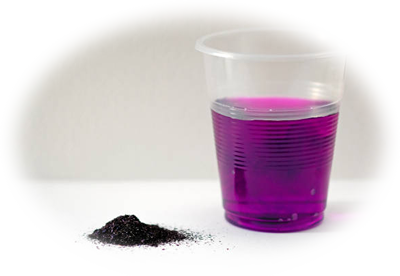Standard level
Water of crystallisation means that water molecules have been incorporated into an ionic lattice. This usually happens in stoichiometric ratios between the water molecules and the ionic compound.
Note: Titrations work better with solution concentrations of between 0.01 and 0.2 mol dm-3.

Background
Potassium manganate(VII) is a powerful oxidising agent which reacts in acidic solution with iron(II) compounds producing iron(III) ions. This, allied to the deep purple colour of the manganate(VII) ion, allows potassium manganate(VII) to be used as a self-indicating titrant for the analysis of iron salts.
manganate(VII) ions reacting with iron(II) ions
5Fe2+(aq) + MnO4-(aq) + 8H+ → 5Fe3+(aq) + Mn2+(aq) + 4H2O(l)
On the reactants, the manganate(VII) ions have an intense purple colour, while on the right hand side iron(III) ions are pale yellow and manganese(II) ions are pale pink in solution. At the concentrations used, all of the products are essentially colourless.
In this experiment, a known mass of a hydrated ammonium iron(II) sulfate is analysed for iron(II) content and the results used to determine the number of water of crystallisation molecules per ammonium iron(II) sulfate formula units.
The calculation requires that the students understand the meaning of a chemical formula.
Hydrated ammonium iron(II) sulfate
(NH4)2Fe(SO4)2.xH2O.
Every formula unit of the salt contains two ammonium ions, one iron(II) ion and two sulfate ions, with an unknown number of water molecules.
This ratio is maintained regardless of the amount of the salt, i.e. one mol of iron to 2 mol of ammonium ions, etc..
Hence, if we can determine the mol of iron(II) ions, we also know the mol of the salt and, from the relative masses of the atoms, its mass.
Requirements
Chemicals
- Potassium manganate(VII) (aq), 0.02 mol dm-3
- Hydrated Ammonium iron(II) sulfate crystals
- Sulfuric acid, 2M
Apparatus
- Burette, 50ml
- Pipette, 25ml
- Volumetric flask, 250ml
- Clamp, boss and stand
- White tile
- Accurately weigh out approximately 10g of the ammonium iron(II) sulfate (hydrated).
- Dissolve the salt in 100 cm3 of 1M sulfuric acid in a volumetric flask and make up to the mark with water.
- Transfer 25ml of the ammonium iron(II) sulfate solution into a conical flask and titrate against the potassium manganate(VII) solution until the first permanent pink colour.
- Repeat the titration until concordant results are obtained.
At the concentrations used in this experiment, none of the components are hazardous except sulfuric acid (1M), which is corrosive and spillages must be cleaned with plenty of water.
Safety glasses must be worn.
